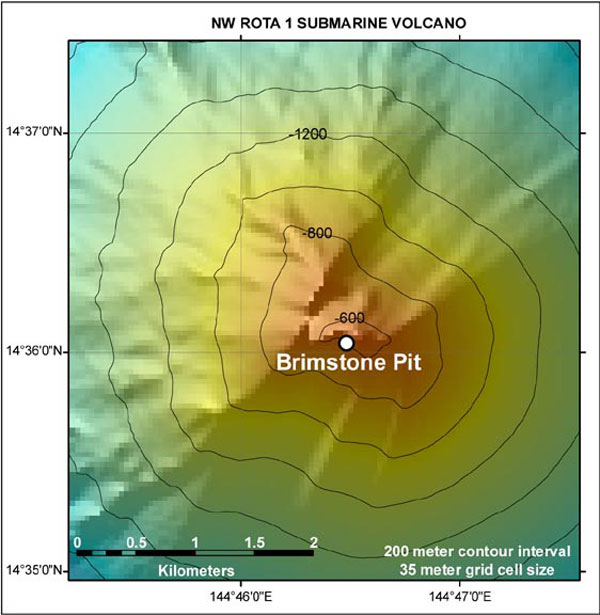
For those of you interested in what happens in the realm of submarine volcanism, I can pass on some tidbits I've gotten about NW-Rota 1, a submarine volcano in the Mariana Islands (see bathymetry above). Dr. Ed Kohut (Petrogenex), a friend of mine from my days at Oregon State Univ., is currently on a JAMSTEC research cruise in the Mariana Islands, visiting the area about NW Rota-1. He reports:
"We just reached NW-Rota 1. It is still actively erupting. To put that in perspective, it has been observed erupting every time it has been visited since 2003. Today's actvity is not as vigourous as in past visits, but there are billowing sulfur laden plumes and the summit has increased ~15 meters since the last ROV visit (in '06?)."
Seems that this seamount continues to chug away under ~500 meters of seawater. It is most famous for the 2004 eruption that coated an ROV that visited the volcano with ash and molten sulfur during an eruption (all under water). Below is a short video from a 2006 research cruise of the vigorous behavior at the vent called "Brimstone Pit", which produced the 2004 eruption. You can clearly see the ash, rock and gases being ejected from the vent, all under half a kilometer of seawater!
thanks for posting that video. very neat.
Just a slightly related question for the chemists that read your blog: Underwater hydrothermal vents (black smokers) precipitate a lot of material. Does this process add or consume CO2 from the surrounding sea water?
Wow, that is an amazing video. To think this is happening continuously at so many differnet locations around the worlds oceans.
Doug,
I think it depends on the reaction. Many of these reactions were the metal precipitates are driven by changes in temperature and pH, so they might not need to complex with CO2 to from the material.
Here is some info on black smokers and some of the chemistry involved:
http://www.whoi.edu/oceanus/viewArticle.do?id=2400
That being said, I am no expert on the chemistry of black smokers, so if anyone out there has some more indepth insight, feel free to chime in.
Oh that is soooo cool. There's an outcrop up on Marys Peak in Alsea Pass that I always imagined forming in just this manner, violent brecciating eruption, but with little steam, thus mainly large, angular clasts. I need to get back up there and take a look, maybe some photos, with this video in mind. Thanks!
Mary's Peak! Let's just say I've been on many-a-fieldtrip to the pillow basalts on Mary's Peak in Oregon.
And a little submarine issue closer to home from a few years ago:
http://seattletimes.nwsource.com/html/localnews/2002197745_seaeruption0…
Did anyone see what this one revealed?
Insightful stuff. I am going to require some time to entertain the info.